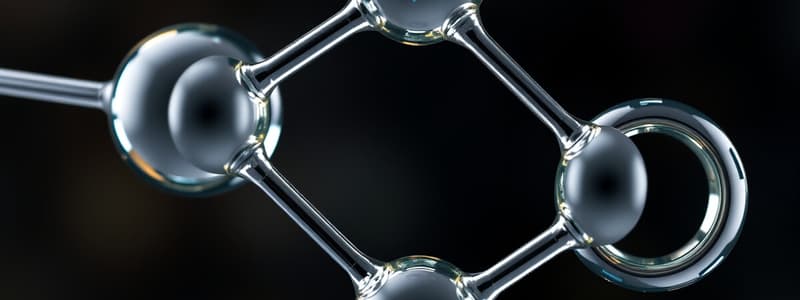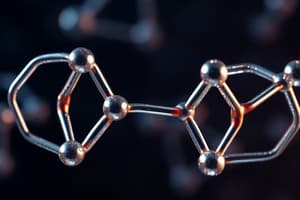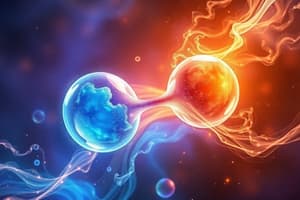Podcast
Questions and Answers
What primarily influences the covalent character of ionic bonds?
What primarily influences the covalent character of ionic bonds?
- The size of the cation only
- The electronegativity of the cation
- The temperature at which the ionic compound is formed
- The polarising power of the cation and polarisability of the anion (correct)
Which theory serves as a better predictor of molecular shapes than the Lewis concept?
Which theory serves as a better predictor of molecular shapes than the Lewis concept?
- Crystal Field Theory
- Molecular Orbital Theory
- Valence Shell Electron Pair Repulsion (VSEPR) Theory (correct)
- Hybridization Theory
What did Fajans' rules primarily explain regarding ionic bonds?
What did Fajans' rules primarily explain regarding ionic bonds?
- The partial covalent character of ionic bonds (correct)
- The polarisation of cations in solutions
- The complete ionic nature of ionic bonds
- The exact bond lengths in ionic compounds
Which of the following factors is NOT mentioned as influencing the extent of ionic bond distortion?
Which of the following factors is NOT mentioned as influencing the extent of ionic bond distortion?
What character do all covalent bonds exhibit to some extent?
What character do all covalent bonds exhibit to some extent?
What type of bond is formed between the two carbon atoms in an ethene molecule?
What type of bond is formed between the two carbon atoms in an ethene molecule?
How do the charges in the CO32– ion affect its total valence electron count?
How do the charges in the CO32– ion affect its total valence electron count?
What does a positive charge on the NH4+ ion signify about its electron count?
What does a positive charge on the NH4+ ion signify about its electron count?
What type of bond exists between two chlorine atoms?
What type of bond exists between two chlorine atoms?
In a CO2 molecule, what type of bond exists between the carbon and oxygen atoms?
In a CO2 molecule, what type of bond exists between the carbon and oxygen atoms?
What is the angle of the distorted tetrahedron shape described?
What is the angle of the distorted tetrahedron shape described?
Which arrangement is more stable based on the provided information?
Which arrangement is more stable based on the provided information?
How many lp—bp repulsions occur when the lp is in an axial position?
How many lp—bp repulsions occur when the lp is in an axial position?
What is the shape described in arrangement (b)?
What is the shape described in arrangement (b)?
Which term best describes the configuration when the lp is in a more stable position?
Which term best describes the configuration when the lp is in a more stable position?
What type of molecular structure is indicated by the presence of lone pairs impacting bond angles?
What type of molecular structure is indicated by the presence of lone pairs impacting bond angles?
In a molecular structure with lone pairs, what is the effect on bond angles?
In a molecular structure with lone pairs, what is the effect on bond angles?
What effect does position have on the stability of the molecular arrangements discussed?
What effect does position have on the stability of the molecular arrangements discussed?
What determines the type of overlap between atomic orbitals?
What determines the type of overlap between atomic orbitals?
Which statement accurately describes positive overlap between atomic orbitals?
Which statement accurately describes positive overlap between atomic orbitals?
What is the significance of the 90° angle between the C-H bonds in methane (CH4)?
What is the significance of the 90° angle between the C-H bonds in methane (CH4)?
Which type of molecules are affected uniformly by the criterion of orbital overlap for bond formation?
Which type of molecules are affected uniformly by the criterion of orbital overlap for bond formation?
In the context of atomic orbital overlap, what do positive and negative signs represent?
In the context of atomic orbital overlap, what do positive and negative signs represent?
What is the geometric arrangement of hydrogen atoms around a carbon atom in methane (CH4)?
What is the geometric arrangement of hydrogen atoms around a carbon atom in methane (CH4)?
Which of the following statements regarding the overlap of s and p atomic orbitals is true?
Which of the following statements regarding the overlap of s and p atomic orbitals is true?
Which of the following molecular shapes results from the arrangement of the three p orbitals in conjunction with hydrogen in CH4?
Which of the following molecular shapes results from the arrangement of the three p orbitals in conjunction with hydrogen in CH4?
What distinguishes odd-electron molecules from other molecules in relation to the octet rule?
What distinguishes odd-electron molecules from other molecules in relation to the octet rule?
Which statement about formal charges is correct?
Which statement about formal charges is correct?
In which situation is the octet rule typically not applicable?
In which situation is the octet rule typically not applicable?
Which of the following is an example of a compound that exhibits an expanded octet?
Which of the following is an example of a compound that exhibits an expanded octet?
What characteristic of elements in the third period of the periodic table allows them to form expanded octets?
What characteristic of elements in the third period of the periodic table allows them to form expanded octets?
Which of the following best describes the nature of molecules with an odd number of electrons?
Which of the following best describes the nature of molecules with an odd number of electrons?
What role do formal charges play in the Lewis structure of a molecule?
What role do formal charges play in the Lewis structure of a molecule?
Which of the following is NOT a characteristic of the expanded octet?
Which of the following is NOT a characteristic of the expanded octet?
Flashcards are hidden until you start studying
Study Notes
Chemical Bonding Concepts
- Ethene consists of two carbon atoms bonded by a double bond.
- Covalent bonds involve the sharing of electrons, demonstrated in molecules like Cl2 and CO2, where Cl-Cl, and double bonds respectively exist.
Valence Electrons and Ions
- Valence electrons are crucial for understanding molecular structures; additional electrons may indicate negative charges (e.g., CO32–) while lost electrons suggest a positive charge (e.g., NH4+).
- Odd-electron molecules such as nitric oxide (NO) and nitrogen dioxide (NO2) do not satisfy the octet rule for all atoms due to their odd number of electrons.
Expanded Octet Rule
- Elements from the third period and beyond can utilize d orbitals in bonding, allowing for more than eight valence electrons around a central atom.
- The octet rule is not applicable for compounds like PF5, SF6, and H2SO4, which exhibit expanded octets.
Covalent and Ionic Bonds
- Both covalent and ionic bonds exhibit partial characters of the other type; the extent of covalent character in ionic bonds can be influenced by the polarizing ability of cations and polarizability of anions.
- Fajans' rules aid in understanding the nature of ionic bonds and their covalent character.
VSEPR Theory
- Valence Shell Electron Pair Repulsion (VSEPR) Theory predicts molecular shapes based on electron pair repulsion.
- Non-bonding electron pairs (lone pairs) significantly alter molecular geometry, as seen with bond angles, e.g., reducing tetrahedral angles from 109.5° to 104.5° due to lone pair-bond pair interactions.
Atomic Orbital Overlap
- Orbital overlap is fundamental for covalent bond formation; positive overlap occurs when orbitals align with the same phase.
- Different overlap types (positive, negative, zero) affect the resulting chemical bond and orientation in space.
Molecular Geometry Examples
- CH4 has a tetrahedral shape with bond angles of 109.5°; NH3 presents a pyramidal shape; H2O shows a bent configuration due to its distinct lone pair arrangements and bond angles.
- In carbon's bonding with hydrogen, four atomic orbitals overlap with hydrogen’s 1s orbitals, resulting in four C-H bonds, although the arrangement is influenced by the shape and angles of the orbitals.
Studying That Suits You
Use AI to generate personalized quizzes and flashcards to suit your learning preferences.




